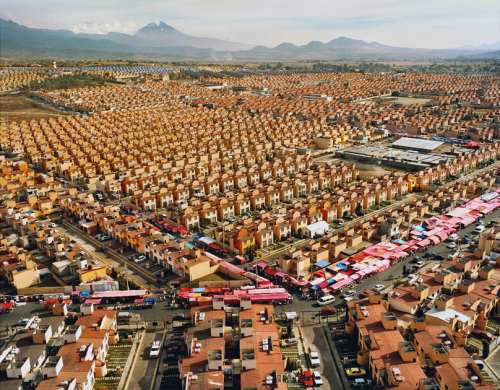Between 2000 and 2006, more than 2.3 million new low-income INFONAVIT homes were built in Mexico, a staggering rate of 2,500 new homes each and every day. The achievement was documented by photographer Livia Corona, who divides her time between New York and Mexico City, in a four-year project entitled “Two Million Homes for Mexico”. The project focuses on the “surge of mass-scale neighborhood developments in Mexico, exploring their role in the ongoing transformation of the ecological, social and cultural landscape of the nation and its citizens.”
As Corona’s photos reveal, while most of the “cookie-cutter” housing developments lack public amenities (schools, clinics) and public spaces (parks), and have few commercial establishments, the people moving into these homes proved remarkably adaptable and creative.
In the photographer’s own words, “Through images, films, and interviews, I look for the space between promises and their fulfillment. In my photographs of multiple developments throughout the country, I consider the rapid redefinition of Mexican “small town” life and the sudden transformation of the Mexican ecological and social landscape. These urban developments mark a profound evolution in our way of inhabiting the world.”
As she explained in an interview with Nina Corvallo for the now-retired Nymphoto blog:
“In my current role as a visual artist, I am often familiarizing with new geographies, both for research and for commissioned assignments. My work is drawn by the underlying structures affecting quotidian survival, and my photographs expand on how these manifest on a broader level.”
“In my current work, Two Million Homes for Mexico, my drive comes from the riddle of what living in these neighborhoods can do to the development of a social and creative expression. What are the manifestations of this experience on the young minds growing up in these insular and remote landscapes, as they draw from a singular cultural and socio-economic backdrop?”
“Developers provided infinite rows of identical 100 to 200 square feet homes. Dwellers are now faced with the task of turning the rows into streets and developments into cities. I am inspired by the inventiveness of people in these neighborhoods, who are adapting with a very hands-on approach—despite a limited infrastructure—to procure a more appropriate living environment. Mexicans, as other Latin Americans, are notoriously gifted in appropriating the built environment. My project both celebrates these small individual triumphs as it frames the challenges and abuses made in providing housing for an ever-expanding population.”
The powerful images of Livia Corona are a worthy resource for urban geography classes.
Related posts:
- Suburbia in Mexico: Alejandro Cartagena’s images of Monterrey
- Are Mexico’s large cities growing faster than small cities?
- The distinctive sounds of Mexico’s towns and cities
- Santa Fe, a case study of a real estate development on Mexico City’s periphery
- A case study of low-income housing on the urban periphery
- Vecindades, Mexico City’s inner-city slums
- Nezahualcoyotl, an irregular settlement which grew into a monster
- Informal settlements or “colonias populares” in Mexico’s cities


Sorry, the comment form is closed at this time.